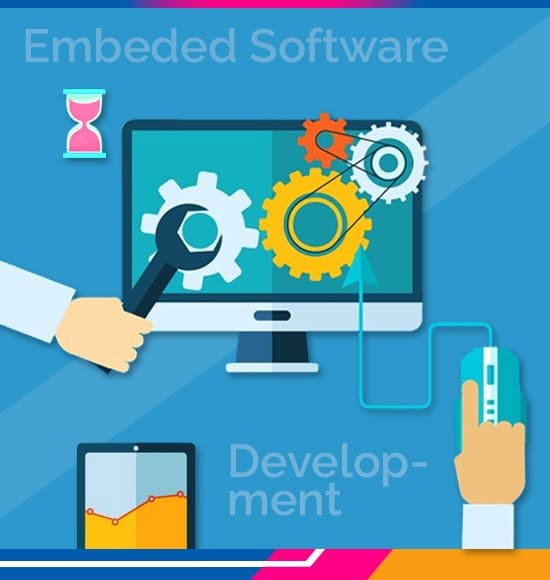Embedded software is a big deal these days. It’s the software that runs on smart devices and makes them work in ways that make our lives easier. It’s super important for businesses to get into embedded software development if they want to stay competitive in today’s tech-driven world. By building devices with embedded software, businesses can create gadgets that improve the customer experience, streamline workflows, and make more money.
Unlike other software, embedded software is designed to work with the hardware it’s built for, which makes it more reliable and efficient. The global embedded software market is expected to grow by 6% and reach $23.9 billion by 2030, according to experts. Additionally, the global embedded computing market is projected to reach $67.29 billion by 2027. The demand for embedded system software development is driven by factors such as the proliferation of IoT devices, advances in hardware technology, automation in industry 4.0, real-time processing, and edge computing.
Role of Embedded Software Systems and Its Types
Embedded systems are an amalgamation of software and hardware that work in tandem. The software controls the hardware components to perform computations, process data, and establish communication with other devices. These systems operate through customized printed-circuit boards, which are designed to program the hardware for specific tasks. This allows embedded systems to perform their functions in real time and deliver quick results to users.
Embedded software systems are developed to function seamlessly with the device hardware, enabling autonomous task performance. Today’s interconnected world relies heavily on various types of embedded software systems, each designed to meet specific requirements. Let’s explore these software systems in detail.
Firmware
The firmware is responsible for handling the essential functions of a smart device. It is a type of embedded software that is stored permanently in the hardware. The firmware typically oversees the booting processes, low-level operations, and hardware interfaces.
Device Drivers
In the realm of embedded software, device drivers serve as vital components that enable the connection between the operating system and hardware devices. They are responsible for establishing a seamless communication channel between the OS and devices like sensors and printers. The optimal functioning of these devices is ensured by these drivers, which play a critical role in connecting the operating system and the hardware.
Real-Time Operating Systems (RTOS)
RTOS, or Real-Time Operating Systems, are specifically designed for real-time embedded systems that require prompt and precise responses. RTOS accomplishes this by effectively scheduling and managing tasks. Its primary function is to ensure the timely execution of critical operations that are essential for the proper functioning of such systems. By enabling quick responses to input stimuli, RTOS plays a vital role in the overall performance of real-time applications.
Middleware
Middleware is a crucial component in embedded systems,that enables smooth communication between different software components. It provides a platform for sharing features and services, simplifying the software development process by eliminating complex capabilities. This helps developers concentrate on their software components’ crucial functionalities while middleware handles the intricacies of inter-component communication.
Embedded Linux
Embedded Linux is a customized version of the Linux operating system that is specifically designed for embedded systems. It provides a reliable and flexible framework for developing software applications for embedded devices and is extensively used in various industries. Its adaptable and dependable features make it a popular choice for developers.
There are different types of embedded software that are designed to support various functions and applications. These software types are examples of the broad range of functions that embedded systems can perform. To develop robust and scalable embedded software, there are specific steps that need to be followed.
Key Steps to Build Effective Embedded Software
The development of embedded systems is a complex process that demands a high degree of precision and a thorough knowledge of hardware and software integration. To create customized embedded software, you must follow a step-by-step process, that involves careful planning, designing, coding, and testing.
Each stage requires a deep understanding of the system’s architecture, functionality, and performance requirements, as well as the programming languages, tools, and frameworks that are necessary for implementation. By following this process meticulously, you can ensure that your embedded system meets the highest standards of quality, reliability, and efficiency.
Defining the Project Scope
To kick off a fruitful embedded software development venture, it’s vital to have a clear vision and well-defined objectives. The initial phase should involve a thorough assessment of the functionalities of your embedded system, identification of the specific application it’s intended for, and a comprehensive understanding of the requirements and limitations that it must meet.
Choosing the Correct Hardware Platform
In the realm of embedded software development, the selection of an appropriate hardware platform plays a pivotal role. It is important to consult with a reliable embedded software development company, to determine the most suitable hardware platform for your solution. While making your decision, you must take into account several factors such as processing speed, memory, communication interfaces, and battery usage. Moreover, it is crucial to opt for hardware that offers easy accessibility and is backed by a strong development ecosystem.
Software Architecture Design
The software architecture of an embedded system is the foundation of your project, ensuring that all the components are interconnected in a smooth and efficient manner. Our experienced embedded software consultants carefully choose the most suitable architecture for your specific needs, whether it be a layered, event-driven, or state-machine architecture. This selection is based on a thorough understanding of the intricacies of embedded systems and ensures the successful implementation of your project.
Creating the Firmware
Developing embedded software primarily involves writing firmware using programming languages such as C, C++, or Python that are compatible with the hardware. The choice of programming language is critical, as it allows developers to make the most of the hardware’s capabilities and implement unique algorithms and logic that cater to the software application’s specific requirements. Effective, concise, and well-documented code is crucial to enabling future modifications and debugging.
Implementing Communication Interfaces
Once the firmware is developed, the embedded software developers incorporate suitable communication interfaces for data exchange and remote control. These interfaces can be either wired, such as SPI, UART or I2C, or wireless, such as Wi-Fi, Bluetooth, or LoRa. The selection of the interface depends on the specific requirements of the project and the preferred communication method.
Ensure Dependability and Security
Security is a top priority, especially when dealing with confidential data or critical operations. As a countermeasure, the development team incorporates robust security mechanisms such as encryption, authentication, and secure boot protocols to safeguard against potential threats.
Performing Tests and Debugging
In order to ensure the smooth functioning of the software in diverse scenarios, the team will go through an extensive testing process. This process comprises a combination of unit, integration, and system testing to identify and repair any bugs at an early stage. Experts employ debugging tools and techniques to quickly detect and fix issues and deliver high-quality software that meets all the technical requirements and user expectations.
Improving Memory Usage and Performance
Your team of experts in embedded system development ensures the reduction of unnecessary overhead expenses by consistently upgrading and monitoring the performance of your embedded software system. This guarantees its smooth functioning and improved memory usage. Now let’s discuss the top embedded software tools designed to streamline your workflow and improve efficiency. By leveraging these highly efficient tools, you can optimize your embedded system development and achieve superior results.
Some Embedded Software Development Tools
Embedded software development tools play a critical role in producing efficient and reliable software for embedded devices. These tools assist developers in managing various aspects of the embedded system development process, such as authoring, debugging, testing, and optimizing code. Some typical tools used for creating embedded software include:
Cross-Compilers
Cross-compilers are indispensable tools for developers who work with embedded systems. They enable the development of code on one platform, such as a PC, which can then be compiled for the target embedded system. This approach saves time and effort by eliminating the need to write code for each individual hardware architecture. Cross-compilers enable developers to efficiently generate code that optimizes resource utilization and performance for the target system.
Integrated Development Environments (IDEs)
Integrated Development Environments (IDEs) provide a comprehensive development environment on a single platform, including tools such as code editors, debuggers, and compilers. For embedded development, popular IDEs include Eclipse, Code Composer Studio, and Visual Studio Code (with modules specifically designed for embedded development).
Debuggers
Debugging is a critical aspect of software development that requires efficient tools to ensure that code is free of errors. In this regard, debuggers play a crucial role in providing developers with the necessary capabilities to identify and fix bugs in real time on the target hardware. These tools offer advanced features such as breakpoint management, which enables developers to stop the execution of their code at specific points to isolate and troubleshoot issues effectively. With these capabilities, developers can streamline their debugging efforts and ensure that their code is reliable and free of errors.
Simulators and Emulators
Simulators and emulators are software tools that enable developers to test and debug their code without the need to deploy it on a physical embedded system. These tools offer a virtual replica of the intended hardware, facilitating quicker and more adaptable testing. This allows developers to identify and fix issues more efficiently, reducing time-to-market and costs associated with hardware development.
System Configuration and Code Generation Tools
Embedded systems development can be simplified by using specialized tools that facilitate configuration and code generation from high-level specifications. These tools offer significant benefits by minimizing manual coding errors and reducing labor.
With the aid of advanced software development tools, developers can significantly improve their productivity, reduce time-to-market, and deliver high-quality software solutions for embedded devices. In the following sections, we will explore some of the most popular embedded software examples.
Real-World Embedded Software Examples
Embedded software is a ubiquitous technology that powers most of the electronic devices and appliances we use in our daily lives. Here are some examples:
Consumer Electronics
Consumer electronics like smartphones, smart TVs, and digital cameras, as well as household appliances, are all equipped with advanced capabilities controlled by embedded software. This software ensures seamless functionality across various smart devices, thereby enhancing the user experience.
Automotive Systems
In the automotive industry, embedded software manages the engine, the anti-lock brake systems (ABS), the infotainment systems, and the driver assistance features of modern cars.
Industrial Automation
In industrial automation, programmable logic controllers (PLCs), industrial robots, and manufacturing equipment utilize embedded software to control processes and monitor operations.
Medical Devices
Medical devices like pacemakers, MRI scanners, and infusion pumps rely on embedded software for accurate control and monitoring. The Internet of Medical Things is also an emerging trend, where embedded software plays a crucial role in advancing the healthcare industry.
IoT (Internet of Things)
IoT devices like smart thermostats, wearables, and home security systems use embedded software to enable communication and data processing.
Embedded Software Systems in Business
Embedded software systems can significantly improve business efficiency by optimizing resource usage, automating operations and improving procedures. In this regard, there are several ways in which embedded software can enhance operational effectiveness in businesses:
Real-Time Monitoring and Control
Organizations can expedite decision-making processes owing to the intricate software that is capable of monitoring and regulating key operations in real-time. The real-time functionality of the software facilitates informed decision-making, minimizes operational downtime, and ensures seamless performance, thereby helping businesses achieve their objectives efficiently.
Data Analytics and Insights
Embedded software is critical in collecting and analyzing data from various sensors and devices. This, in turn, empowers businesses to obtain valuable insights based on data, which can lay the groundwork for enhancing business operations and achieving better outcomes.
Process Automation
Incorporating embedded software can lead to the automation of time-consuming and repetitive tasks, reducing the need for human intervention and the potential for errors. By employing intelligent automation, workflows can be executed with greater speed and precision, resulting in significant savings in terms of time and resources.
Integration with Existing Business Systems
The integration of Customer Relationship Management (CRM) and Enterprise Resource Planning (ERP) systems can significantly improve overall business coordination and facilitate smooth data flow. Embedded software is crucial in ensuring efficient communication and synchronization between different organizational departments and functions by interfacing with these systems. Furthermore, embedded software systems allow for remote management and connectivity, which can lead to increased operational efficiency and flexibility.
Remote Management and Connectivity
Embedded software systems provide a means for remotely managing and connecting devices, enabling organizations to oversee and regulate their devices from any location. This remote management access facilitates more effective upgrades, troubleshooting, and maintenance procedures, enhancing operational efficiency.
Predictive Maintenance
Businesses can take advantage of embedded software to anticipate device issues and schedule maintenance in advance by running predictive maintenance algorithms. This proactive approach helps to minimize unplanned downtime and maximize asset utilization. By analyzing data and identifying potential problems before they occur, businesses can take the necessary actions to prevent equipment failures and optimize operational efficiency.
Having learned about the benefits of embedded software, including its examples, tools, and development process, it is now time to move on to the final part, cost estimation.
Key Considerations for Embedded Software Development Estimation
Considering the financial aspect of developing and implementing embedded software into your existing systems is important. The cost estimation process involves a thorough analysis of various factors, including
Project Scope and Complexity
To estimate the project’s cost accurately, it is essential to outline the project’s scope, including the hardware platform, desired functionality, and performance goals. The level of customization required and the complexity of the embedded system will significantly impact the development cost.
Integration and Compatibility
Evaluating integration and compatibility is also crucial, as the process required to integrate the embedded software with current systems or external components can be complex and costly. Ensuring interoperability with other systems may require additional resources and effort.
Regulatory Compliance
Regulatory compliance is another critical factor that can impact the cost of embedded system software development. If the embedded software needs to adhere to particular industry norms or laws, extra work and expenses are involved.
Software and Hardware Requirements
Identifying the software and hardware elements required for embedded system software development is also important. The cost of various hardware platforms and software licensing may vary, impacting the project budget significantly.








